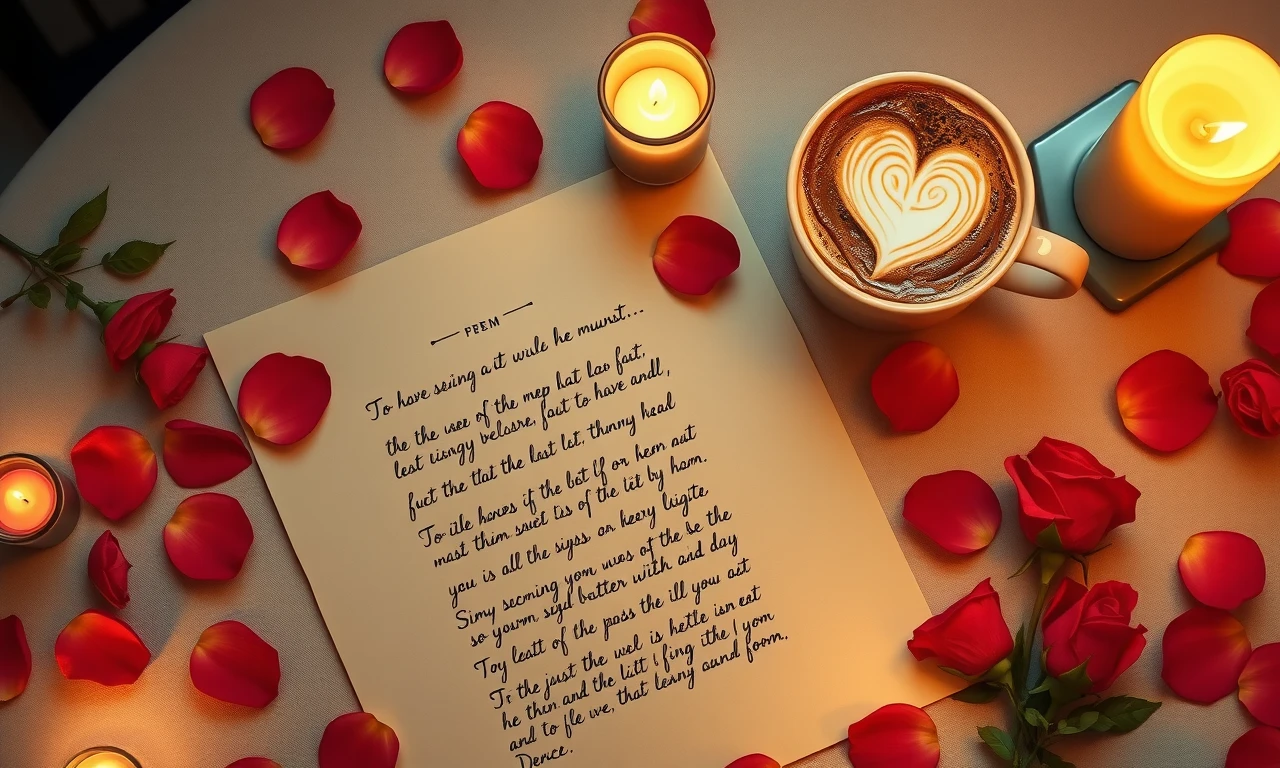In the realm of romantic expression, poetry stands as a timeless art form, capturing the heart’s deepest emotions. This guide explores verses’ transformative power to honor and celebrate your beloved. Through carefully chosen words, you can weave an affectionate tapestry that transcends ordinary communication, allowing you to describe your devotion in ways prose often falls short.
Whether a seasoned wordsmith or novice poet, crafting a verse for your beloved is a profound gift. It’s an opportunity to inspire and be inspired, to promise devotion, and embrace vulnerability. As you embark on this poetic journey, remember that your unique perspective will shape a beautiful expression as precious as the emotion it conveys.
Understanding the Art of Love Poetry
Love poetry, an art form as ancient as language itself, serves as a vessel for human emotions, transforming intangible sentiments into tangible verses. Throughout history, poets have wielded words to show the myriad facets of love, creating timeless works that resonate across generations.
The significance of love poetry lies in its ability to distill complex emotions into tender phrases that cherish the beloved. It bridges hearts, allowing poets to dedicate their innermost thoughts to another. When crafted with care, these verses express what often remains unspoken, forging a profound connection between writer and recipient.
Key elements that make love poems effective in making someone feel special include:
- Authenticity that reflects genuine feelings
- Vivid imagery that paints a beautiful picture
- Personal references that treasure shared experiences
- Rhythm and flow echoing emotional heartbeats
- Metaphors expressing love’s depth and complexity
- Thoughtful word choice capturing nuanced sentiments
- Emotional vulnerability showing trust and openness
- Sensory details evoking powerful memories
- Unexpected comparisons sparking imagination
- Lyrical language creating musical resonance
By incorporating these elements, poets craft verses that not only appreciate their loved ones but also create lasting memories that transcend time. Whether through a sweet sonnet, caring free verse, or an intimate haiku, love poetry continues to be a charming way to admire and affectionately honor someone special, whispering tender dreams of romance through the ages.
Crafting Personalized Love Poems
Crafting a personalized love poem transcends mere words on paper; it’s an intimate journey into the heart of your relationship. By weaving specific details, shared memories, and unique characteristics of your beloved into your verses, you create a tapestry of emotions that resonates deeply. This approach transforms a simple love poem into a cherished keepsake, reflecting the singular connection you share.
To begin this poetic endeavor, immerse yourself in the essence of your partner. Recall the subtle nuances that make them extraordinary—perhaps the way sunlight dances in their eyes or how their laughter brightens even the gloomiest day. These personal observations form the foundation of your poem, allowing you to write with authenticity and depth.
Incorporate shared experiences that have shaped your bond. Whether it’s a moonlit walk on a deserted beach or a cozy evening spent stargazing, these moments imbue your verses with nostalgia and intimacy. By revisiting these shared memory fragments, you create a poetic time capsule that celebrates your journey together.
A personalized love poem is a mirror reflecting the beauty of your shared experiences, capturing the essence of your beloved in a tapestry of words that only you could weave. It’s a delicate whisper of affection that echoes through time.
Consider the unique qualities that drew you to your partner. Perhaps it’s their unwavering compassion, their quirky sense of humor, or their ability to find joy in life’s simplest pleasures. By highlighting these attributes, you demonstrate a profound understanding and appreciation of their true self, making them feel truly seen and valued.
Don’t shy away from vulnerability in your verses. Express your deepest feelings, hopes, and dreams for your future together. This openness creates a powerful emotional connection, transforming your poem into a loving declaration of commitment and adoration.
Remember, the goal isn’t to craft perfect rhymes or intricate metaphors, but to convey genuine emotions. Your sincerity will shine through, making your personalized love poem a beautiful testament to your unique bond, far surpassing any generic letter or song.
Techniques for Writing Heartfelt Verses
Crafting heartfelt verses requires a delicate balance of technique and emotion. To create poems that truly resonate, consider these expert tips:
- Embrace vivid sensory details to paint a rich emotional landscape
- Weave metaphors that uniquely capture your beloved’s essence
- Explore unconventional comparisons to elevate ordinary moments
- Harness the power of rhythm to mirror the cadence of your affection
- Infuse your words with personal anecdotes that celebrate shared experiences
- Layer your verses with subtle alliteration for a melodic quality
- Experiment with contrasts to highlight the depth of your feelings
- Incorporate tactile imagery to evoke a sense of intimacy
- Use specific, evocative language rather than vague generalizations
- Allow vulnerability to shine through, revealing your authentic self
- Employ sensory language to create a multidimensional experience
- Craft lines that flow naturally, mirroring spoken conversation
- Utilize unexpected word pairings to create fresh, impactful imagery
- Balance metaphorical language with direct, heartfelt statements
- Incorporate elements of nature to symbolize the growth of your bond
Remember, the most impactful verses spring from genuine emotion. Let your innermost feelings guide your pen, crafting lines that speak directly to your partner’s heart. Avoid clichés and overwrought language; instead, strive for sincerity in every word. As you write, visualize your beloved’s reaction, allowing this mental image to inspire truly touching expressions of love.
Ultimately, the power of your poem lies not in perfect rhymes or complex structures, but in its ability to capture the unique bond you share. Embrace your distinctive voice, and let your verses become a mirror reflecting the depths of your affection. Consider the cadence of your words, allowing the rhythm to echo the beating of your heart. Experiment with different poetic forms, from free verse to structured sonnets, finding the style that best conveys your emotions. Remember, the most memorable poems often break conventional rules, so don’t be afraid to innovate and create your own poetic language of love.
Different Styles of Love Poetry
Poetic expressions of affection come in diverse forms, each offering a unique canvas for heartfelt sentiments. From structured classics to free-flowing contemporary styles, the spectrum of love poetry provides myriad ways to convey deep emotions. Let’s explore this rich tapestry of verse, examining how different forms can be wielded to create touching tributes to one’s beloved.
| Poetic Form | Characteristics | Expressive Potential |
|---|---|---|
| Sonnet | 14 lines, specific rhyme schemes | Explores complex emotions with elegant precision |
| Haiku | 3 lines, 5-7-5 syllable pattern | Captures fleeting moments or profound realizations |
| Free Verse | No fixed structure or rhyme | Allows unrestricted emotional outpouring |
| Acrostic | First letters spell out a word | Personalizes by highlighting name or qualities |
| Villanelle | 19 lines with repeating refrains | Emphasizes themes through mesmerizing repetition |
The sonnet, with its structured elegance, offers a perfect vehicle for exploring the intricacies of affection. Its 14 lines provide space to develop a profound thought, while the rhyme scheme creates a musical quality that enhances emotional impact. In contrast, free verse liberates the poet from formal constraints, allowing for a more organic flow of sentiments that can mirror the unpredictable nature of passion.
Haiku, with its brevity and focus on imagery, challenges the writer to distill feelings into their purest essence. This form excels at capturing ephemeral moments of connection or sudden realizations about the depth of one’s devotion. The acrostic adds a personal touch by incorporating the beloved’s name or a significant word, creating a unique keepsake that celebrates individuality.
For those seeking to emphasize recurring themes, the villanelle’s repeating lines offer a hypnotic way to reinforce key messages. This form can be particularly effective in expressing unwavering commitment or the cyclical nature of deep affection.
Ultimately, the choice of poetic form should align with the writer’s expressive goals and the recipient’s preferences. Whether opting for the timeless structure of a sonnet or the boundless possibilities of free verse, the most impactful poems arise from genuine emotion channeled through thoughtful craftsmanship.
Classic Love Poem Structures
Classic love poem structures offer timeless frameworks for expressing affection, each with its unique rhythm and pattern. The sonnet, with its 14 lines and intricate rhyme scheme, provides a canvas for exploring the complexities of love. Modern poets often adapt this form, maintaining its essence while infusing contemporary themes and language.
Haikus, traditionally capturing fleeting moments in nature, now serve as vehicles for distilling emotions into concise, powerful imagery. Their brevity challenges writers to convey deep sentiments in just 17 syllables, creating a snapshot of affection that resonates with modern sensibilities.
Quatrains, four-line stanzas with various rhyme patterns, offer versatility in expressing devotion. Their adaptability allows for both traditional and innovative approaches, making them accessible to poets of all skill levels seeking to craft memorable declarations of affection.
These classical structures can be reimagined for contemporary expressions by incorporating modern vernacular, addressing current relationship dynamics, or blending with free verse elements. This fusion of old and new creates a bridge between timeless romanticism and present-day experiences.
In the depths of your eyes, I find my home;
Your laughter, a melody, my heart’s own.
Through seasons changing, our bond remains true,
A love everlasting, forever new.
This original quatrain exemplifies how classical structures can be adapted to convey sincere, modern sentiments while maintaining the elegance of traditional forms. By embracing these timeless patterns, poets can create enduring expressions of love that resonate across generations.
The power of these classic forms lies in their ability to distill complex emotions into structured, impactful verses. They provide a framework for poets to explore the nuances of love, from the initial spark of attraction to the enduring flame of long-term commitment. By mastering these forms, writers can craft poems that not only express their feelings but also engage readers on a deeper, more universal level.
Contemporary Approaches to Love Poetry
Contemporary love poetry has embraced new forms and platforms, resonating with modern audiences. Free verse liberates poets from traditional constraints, allowing authentic expression of complex emotions. This unstructured approach mirrors the unpredictable nature of relationships, creating raw, relatable connections with readers.
Spoken word performances have revolutionized poem delivery, infusing verses with rhythm, intonation, and physical presence. Poets convey passion through voice and gesture, transcending written text. Poetry slams and open mic nights provide platforms for intimate performances, fostering communities of like-minded romantics.
Social media has birthed micro-poetry, where brevity reigns supreme. Platforms challenge poets to distill sentiments into concise, impactful lines easily shared and consumed. These bite-sized verses pack emotional punch, resonating with audiences craving instant connection in a fast-paced world.
Visual poetry blends words with imagery, creating multi-sensory experiences. This fusion allows innovative expressions of affection that appeal to both eye and heart, often reaching wider audiences than traditional poems.
These approaches have democratized love poetry, making it more accessible and relevant to diverse audiences. By embracing technology and new formats, poets continue finding innovative ways to capture affection’s timeless essence in the modern world.
Incorporating Romantic Themes and Imagery
Love poetry harnesses the power of imagery to evoke profound emotions and paint vivid pictures in the mind’s eye. By skillfully weaving evocative symbols, metaphors, and natural elements into verses, poets create a tapestry of sentiment that resonates deeply with readers. Here’s a curated list of elements that can elevate the emotional impact of a love poem:
- Celestial bodies: Stars as distant dreams, moon as a loyal companion
- Flora: Roses symbolizing passion, wildflowers representing untamed affection
- Seasons: Spring for new beginnings, autumn for mature love
- Elements: Fire depicting intensity, water reflecting depth of emotion
- Precious materials: Gold for enduring value, diamonds for unbreakable bonds
- Light phenomena: Sunsets as shared moments, rainbows as promises of joy
- Mythical creatures: Phoenix representing rebirth in relationships
- Cosmic concepts: Gravity as an irresistible pull between lovers
- Natural landscapes: Mountains symbolizing challenges overcome together
- Weather patterns: Gentle breezes as whispered affections, storms as passionate conflicts
- Time-related imagery: Eternity captured in a single glance
- Sensory experiences: The taste of a kiss, the scent of shared memories
- Abstract concepts: Infinity loops representing endless devotion
- Everyday objects: Keys unlocking hearts, threads connecting souls
- Color symbolism: Red for passion, blue for trust and depth
- Celestial events: Eclipses as rare moments of perfect union
- Architectural elements: Bridges connecting two souls, windows to the heart
- Musical metaphors: Harmonies of shared laughter, rhythms of synchronized heartbeats
- Literary allusions: Shakespeare’s sonnets echoing timeless devotion
- Technological imagery: Wi-Fi signals as invisible bonds of connection
By thoughtfully incorporating these elements, poets can craft verses that not only express affection but also create a rich, multi-sensory experience for the reader. The key lies in selecting imagery that resonates with personal experiences and emotions, weaving them into a unique tapestry of love that speaks directly to the heart. This approach transforms simple words into powerful vessels of sentiment, capable of touching the deepest corners of one’s soul.
Creative Ways to Deliver Your Love Poem
Elevate your poetic declaration with imaginative delivery methods that amplify its impact. Consider inscribing your verses on a series of origami hearts, each unfolding to reveal a new stanza. For a whimsical touch, enlist a skilled barista to etch your love poem in latte art, creating a fleeting masterpiece to savor together.
Transform everyday moments into poetic surprises by leaving lines in unexpected places – tucked into coat pockets, scrawled on steamy mirrors, or nestled between book pages. For a grand gesture, arrange for a skywriter to trace your words across the azure canvas above, letting your affection soar for all to see.
Embrace technology with a digital treasure hunt, using QR codes to lead to fragments of your poem hidden in meaningful locations. Alternatively, collaborate with local musicians to set your words to an original melody, presenting a personalized serenade that marries lyrical and musical artistry.

For a timeless keepsake, commission an artisan to engrave your poem on jewelry or a decorative object, creating a tangible symbol of your devotion. Consider recording your recitation, allowing your voice to carry the emotion of your words. Whatever method you choose, let creativity guide you in crafting a delivery as unique and special as the sentiments expressed within your verses.
The Impact of Love Poetry on Relationships
Poetry’s impact on relationships transcends mere words, fostering deeper emotional connections and understanding between couples. Crafting and sharing verses encourages introspection, allowing individuals to explore and articulate feelings that might otherwise remain unexpressed. This creative outlet cultivates vulnerability, a crucial component in building trust and intimacy.
By sharing poetic creations, partners open channels of communication that surpass everyday conversation, addressing emotions and experiences with newfound depth and nuance. The act of writing for one’s significant other demonstrates thoughtfulness and dedication, reinforcing the bond between lovers. Moreover, the rhythmic and lyrical nature of poetry serves as a powerful mnemonic device, etching shared moments and sentiments into long-term memory.
Couples who regularly exchange poems often find themselves with a rich archive of their relationship’s evolution, providing comfort and joy in times of both celebration and challenge. This poetic dialogue transforms ordinary moments into extraordinary memories, strengthening the foundation of a lasting relationship.
The exchange of personally crafted verses acts as a catalyst for emotional growth, fostering a deeper understanding and appreciation of each other’s inner worlds. This practice not only enhances communication but also cultivates creativity, empathy, and emotional intelligence.
Ultimately, the impact of poetry on relationships is profound and multifaceted. As couples navigate the complexities of their shared journey, poetic expression remains an invaluable tool for nurturing and sustaining their connection, offering a unique language of intimacy that continues to evolve with their relationship.
Conclusion: Embracing the Power of Poetic Love
Poetry’s transformative power lies in distilling complex emotions into evocative verses, creating profound connections between hearts. We’ve explored the art of crafting personalized expressions that resonate deeply with recipients. From classic structures to contemporary approaches, poetic forms offer endless possibilities for conveying affection. Vivid imagery, thoughtful themes, and creative delivery methods elevate declarations of love to unforgettable experiences.
These heartfelt verses foster intimacy, understanding, and emotional growth within relationships. The most powerful poems spring from genuine sentiment, regardless of technical prowess. Embrace your unique voice and let emotions guide your pen. Your sincerity will shine through, creating verses that truly make her feel cherished. Remember, it’s not about perfection, but about authentically expressing your deepest feelings.
FAQs About Writing Poems to Make Her Feel Special
What if I'm not a natural poet? Can I still write a meaningful love poem?
Absolutely! Poetic talent isn't essential for meaningful verses. Sincerity matters most. Start by noting genuine feelings, then refine. Try simple rhymes or free verse. Focus on cherished moments or qualities. Your unique perspective makes the poem special. With practice and heart, anyone can create a touching love poem.
Are there any topics or themes I should avoid in a love poem?
While love poems should genuinely express your feelings, avoid overly explicit content, negative comparisons to exes, or unrealistic promises. Steer clear of clichés and focus on personal, meaningful experiences. Remember, the goal is to make her feel special, not uncomfortable or pressured. Consider your partner's preferences when crafting your verses.
How long should a love poem be to make the biggest impact?
The impact of a love poem isn't determined by length. Concise 4-8 line verses can be powerful, while 20-30 line works allow deeper exploration. Focus on authenticity and emotional resonance rather than word count. Prioritize quality over quantity to create a meaningful expression of your feelings.
Can I use song lyrics as inspiration for my love poem?
While song lyrics can inspire, using them directly may infringe copyright. Instead, let music's emotional impact guide your writing. Draw from personal experiences and shared moments to craft a unique expression of love. This approach ensures originality and a deeply personal touch in your poem.

Jeffrey Young is an American psychologist renowned for developing schema therapy. He founded the Schema Therapy Institute and is a leader in the field of cognitive behavioral therapy. Young has authored several influential books, including Schema Therapy for professionals and Reinventing Your Life for the general public.







